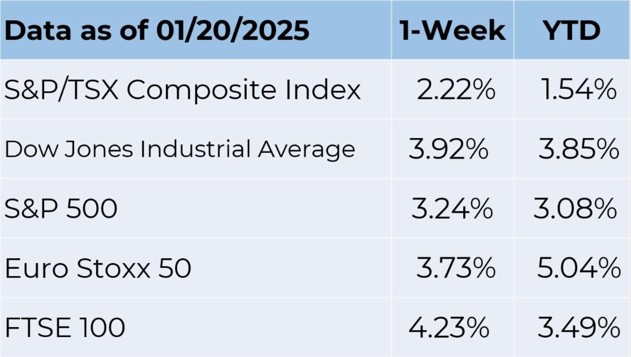Weekly Market Commentary January 23 2025
Canada Inflation Boost
Canadians can heave a sigh of relief despite the ongoing risk of the country being hit with a 25% tariff by the US. That's because inflation is increasingly dropping, strengthening the prospect of the Bank of Canada carrying further interest rate cuts. The currency market is already pricing an 81% chance that the central bank will conduct a 25-basis point rate cut on January 29.
The prospect of an 81% rate cut comes on the backdrop of the country's annual inflation slowing in December. Annual inflation dropped to 1.8%, lower than expected and below the prior month's 1.9%. The inflation level edged lower in part because of a tax break that kicked off in the middle of the month, therefore helping bring down prices of alcohol, restaurant foods, and children's clothing.
The sales tax break, which affected a tenth of the CPI basket's components, will last until the middle of February. In January, there will be a full month-long exemption, as opposed to just 18 days in December. The Bank of Canada lowered its key policy rate by 175 basis points from June to 3.25% thanks to the steady easing of prices, which have remained at or below the bank's target of 2% since August.
The upcoming rate cut will be another departure from the US Federal Reserve, but it may be required to keep inflation close to 2% and stimulate growth. Nevertheless, the outlook for inflation is still clouded by uncertainty surrounding trade policy.
Tariffs would be inflationary and could reverse the recent gains toward price stability, even though they have essentially been restored. For now, rate decisions will probably be made by the Bank of Canada on an individual basis. Additionally, core inflation metrics have been well below the upper range of 3% and have been gradually approaching the 2% target.
Meanwhile, calmness is slowly creeping into the Canadian stock market as investor's access clues about US President Donald Trump's trade policies. Canadian main stock index, the Toronto Stock Exchange, has already risen to 5-week highs in the aftermath of Trump holding back on trade tariffs.
The TSX has already recorded six straight sessions of gains and is once again above the 25,000 level, buoyed by increases in the materials, tech, and utilities sectors. Nevertheless, the energy sector remains under pressure as oil prices tanked on Trump, indicating plans to boost US oil and gas production, which could lead to a glut in supply.
Citing worries about fentanyl smuggling and illegal immigration, Trump stated he was considering enacting 25% duties on Canada and Mexico beginning February 1. In the meantime, Canadian Prime Minister Justin Trudeau declared that his administration was prepared to react in any situation if Trump imposes tariffs on Canada.
The Markets
As the markets turn.
Last week, investors breathed a sigh of relief when the latest price data showed core inflation, which excludes volatile food and energy prices, moved lower in December.
Investors has been worried because economists forecasted inflation would be stickier in December, reported Frank Lee of Morningstar. If that proved out, the Fed might have stopped lowering the federal funds rate, which would have had adverse implications for company performance and stock prices. So, when core inflation dropped to 3.2 percent year over year, investors celebrated.
Some think the celebration might be premature.
Jacob Sonenshine of Barron’s reported, “Stocks jumped after this week’s inflation data. The problem is that there’s not a lot to love in the numbers. The reality is that inflation remains well above the Federal Reserve’s 2 [percent] goal. The average headline [Consumer Price Index] has been 2.7 [percent] in the past three months, above the 2.6 [percent] average for the three months that ended in September. So, the trend of inflation, when considering a larger sample size of results, is inching higher, not lower…The result is that the Fed is unlikely to reduce interest rates aggressively. The federal-funds futures market now expects just one interest-rate cut this year…”
Inflation wasn’t the only reason investor optimism surged last week, though. Fourth quarter earnings season—the time when management lets investors know how the companies performed in the prior quarter—got off to a strong start. “Big Banks set a positive note earlier this week, while [a large semiconductor company] sparked further enthusiasm among chip stocks. Things will only heat up in the weeks ahead, as Wall Street sizes up results from the market's heaviest hitters,” reported Connor Smith of Barron’s.
We should all be prepared for markets to be volatile this year.
While last week delivered attractive gains overall, the week before stock and bond markets moved in the opposite direction. Jurrien Timmer of Fidelity explained why we may see significant volatility this year:
“While I continue to believe we are in a bull market—with rising earnings poised to pull the weight of the market still higher—this recent volatility could be a sign of things to come. Later stages of a bull market tend to be more volatile. And it doesn’t take as much to disrupt the market’s mojo when valuations like price-earnings (PE) ratios are high, as they have been. But moreover, I believe the interest-rate angst that’s been weighing on the market isn’t likely to go away anytime soon and could be a recurring feature of the year ahead.”
Last week, major U.S. stock indices rose sharply, and yields on longer maturities of U.S. Treasuries fell.

Source: FactSet
The Costliest Natural Disasters in U.S. History
The Los Angeles wildfires were still burning when this was written, and it’s not yet possible to understand the full economic impact of the event. Last week, AccuWeather “increased its preliminary estimate of the total damage and economic loss to between $250 billion and $275 billion,” reported Monica Danielle. A week earlier, the estimate had been $52 billion to $57 billion.
If the new forecast holds up, it puts the wildfires at or near the top of the list of costliest natural disasters in the United States. Not including the wildfires, six of the top 10 events have happened over the past decade. Here are the top 10, as listed in AARP.org using data from the National Oceanic and Atmospheric Administration (NOAA). (All dollar figures were adjusted for inflation.)
|
Hurricane Katrina, 2005, |
$201.3 billion |
|
Hurricane Harvey, 2017, |
$160.0 billion |
|
Hurricane Ian, 2022, |
$115.2 billion |
|
Hurricane Maria, 2017, |
$115.2 billion |
|
Superstorm Sandy, 2012, |
$88.5 billion |
|
Hurricane Ida, 2021, |
$84.6 billion |
|
Hurricane Helene, 2024, |
$78.7 billion |
|
Hurricane Irma, 2017, |
$64.0 billion |
|
Hurricane Andrew, 1992, |
$60.5 billion |
|
United States drought/heat waves, |
$54.6 billion |
In 2024, there were 27 weather and climate events that inflicted damage of $1 billion or more. Since 1980, there have been 403 events of that magnitude, with a total price tag of more than $2.9 trillion, reported NOAA.
Weekly Focus – Think About It
“[Jimmy Carter] had the courage and strength to stick to his principles even when they were politically unpopular…Fifty years ago, he was a climate warrior who pushed for a world where we conserved energy, limited emissions, and traded our reliance on fossil fuels for expanded renewable sources. By the way he cut the deficit, wanted to decriminalize marijuana, deregulated so many industries that he gave us cheap flights and, as you heard, craft beer. Basically, all those years ago, he was the first millennial. And he could make great playlists…”
—Jason Carter, grandson of former U.S. President Jimmy Carter
Best regards,
Eric Muir
B.Comm (Hons. Finance), CIM®, FCSI
Senior Portfolio Manager
Derek Lacroix
BBA, CIM®, CFP®
Associate Portfolio Manager

P.S. Please feel free to forward this commentary to family, friends or colleagues. If you would like us to add them to the list, please reply to this email with their email address and we will ask for their permission to be added.
Disclaimer:
Information in this article is from sources believed to be reliable, however, we cannot represent that it is accurate or complete. It is provided as a general source of information and should not be considered personal investment advice or solicitation to buy or sell securities. The views are those of the author, Eric Muir and Derek Lacroix and not necessarily those of Raymond James Ltd. Investors considering any investment should consult with their Investment Advisor to ensure that it is suitable for the investor’s circumstances and risk tolerance before making any investment decision. Raymond James Ltd. is a Member Canadian Investor Protection Fund.

